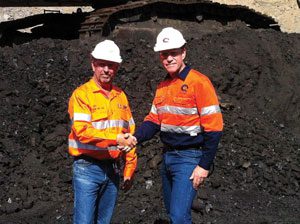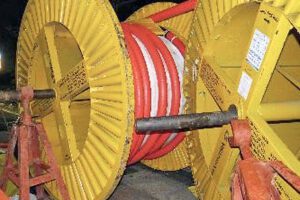1000 days injury free is no mean feat for any industry. Director of SAB Mining, Scott Browne, explains how his team was able to achieve this milestone on two of QCoal’s Bowen Basin mine sites.
Earlier this year QCoal’s Sonoma and Cows sites near Collinsville achieved 1000 days injury free. What do you see as the most important factor in maintaining an injury and fatality free workplace over such a long time period?
 A combination of things, firstly a genuine commitment to safety is absolutely fundamental. It should be an ingrained commitment, something that you just do.
A combination of things, firstly a genuine commitment to safety is absolutely fundamental. It should be an ingrained commitment, something that you just do.
I also believe that leadership is important, to ensure that your people know that you have their safety as the top priority. If people are pressured by production targets, the tendency often is to cut corners. This is not acceptable. It is vital that we keep our people calm and make certain they don’t put themselves at risk.
I think what SAB Mining does differently is we keep our operators motivated. Driving up and down a haul road for 12 hours a day in a dump truck is mind-numbing, attention wanes when you’re bored and this is when incidents occur. We make sure our operators are multi-skilled – in 18 months or less our operators have five or six coal competencies. It’s also not unusual for our operators to work on two different machines in the same shift. This focus on multi skilling operators in my opinion is crucial to the achievement of our safety record and to developing the careers of our people.
Recent reports have shown that contractor fatalities on mine sites are disproportionately greater than employee fatalities. Why do you think this is so?
I really worry about this. As the industry downturn continues and coal prices continue to fall, the pressure to drive costs down is felt keenly by both mining companies and contractors.
In my opinion the majority of contractors are short-term focused – it’s all about making money, today, this week, this month, this year. This leads to corners being cut and mistakes made. Contractors’ workforces may therefore be subject to more risk, and accidents occur.
Our approach at SAB Mining is to develop strong enduring relationships with our client. It’s not about getting the most we can during the boom times and tightening our belts during tougher times. It’s about supplying a consistent, fair and mutually beneficial service that is sustainable regardless of where we are in the cycle. That way we don’t cut corners and we send all of our people home safely every day.
How are you addressing safety issues around drug and alcohol use and dependency amongst your workforce?
We have a zero tolerance to both drugs and alcohol on site.
Random breath testing occurs daily and random drug testing occurs two or three times a month. Again, this is about commitment, if people are empowered to do their job correctly, by necessity this means that they need to be fit for work.
I expect our team to be proud of the work they do and to be able to do this they need to be in good shape. I think that if people take pride in their work, they take ownership of their personal fitness. So this extends beyond alcohol and drug usage; it relates to nutrition, hydration, and physical fitness. If this ownership occurs, then people don’t need their boss wielding a big stick over them about alcohol or drug consumption.
Safety messaging that is repeated too often on a mine site stands in danger of becoming like so much wallpaper and background noise. How do you keep the safety message fresh and relevant to your workforce?
I agree with this – the safety message has lost traction because of the fancy words and rhetoric often associated with it. I’m a cynic about this because I think a lot of people talk safety, but when push comes to shove, production is all that matters. The safety message is then diluted because workforces see that their bosses really are just paying lip service to it.
We try to keep it fresh the same way we do everything else – encourage ownership by everyone at the mine site. We update safety topics every three or four days, and identify two relevant issues to discuss in toolbox talks. We encourage everyone to take part, we share photos from other mine sites, discuss incidents that have occurred elsewhere and we never get complacent.
Is there a case for harsher penalties for mine operators who don’t meet their safety obligations?
This is a difficult question and divides people in their responses. My view is yes. Mine operators must be held accountable as do employees.
Incidents occur frequently because people who are inappropriately trained or skilled are put into situations for which they are ill-equipped. The supervisor who puts individuals at risk should be challenged, as should the management team. We need a management style that allows employees to feel comfortable enough to put their hands up if they feel uncertain about the task at hand. We need supervisors to embrace leadership styles that allow this to happen.
Everyone in a supervisory capacity, needs to have the confidence and desire to question themselves and ask themselves if they contributed to the decisions their reports make.
How do you address fatigue management on your mine sites and do you think long shifts and 24 hour rostering has a detrimental effect on mine workers’ health?
I’m sounding like a broken record but my answer is the same. Individuals have to value their own contribution to the workplace sufficiently to ensure they come to work rested and in a fit state to perform.
Working 12 hour shifts, especially night shifts, can certainly be tough, and not everyone has the capability and metabolism to be successful working such rosters. However on balance my view is that the lifestyle roster provides coal mine workers with a great opportunity to enjoy more family and leisure time along with a lucrative career.
If people take ownership of their own physical condition, I believe that fatigue can be managed. At SAB Mining the majority of our workers are on a 7 and 7 continuous roster which they enjoy.
Multiskilling people to reduce boredom, providing training in fitness for work (not just managing fatigue), and challenging each person to accept responsibility for their own safety and that of others all helps to build a culture of alertness.
At SAB Mining we recognise that fatigue is a significant factor and as such, we encourage our people to raise their hands when feeling fatigued at work and through good team behaviors, the crew often undertakes job rotation throughout the shift to eliminate fatigue related issues. Our client QCoal also understands the risk of fatigue and assists us by ensuring that fatigue rooms are made available before our employees embark on their journey home.
What do you see as the biggest challenge to mine safety in Queensland today?
I don’t think of mining as a dangerous occupation, it’s just another job. It’s probably more dangerous herding cows around a farm, or driving trucks interstate.
We have an audience who is captive – our employees can be educated, we control the message and we can drive a culture that ensures that each of them goes home safely at the end of the day.
The biggest challenge in the industry is how to drive a culture of safety ownership amongst all coal mine workers. We have to reduce the rhetoric and get on with it.
“The biggest challenge in the industry is how to drive a culture of safety ownership amongst all coal mine workers. We have to reduce the rhetoric and get on with it.”
 PROFILE
PROFILE
SCOTT BROWNE DIRECTOR,
SAB MINING
Scott Browne started with SAB mining in 2006 after a successful mining career which spanned 22 years, predominantly in production and leadership roles within the Rio Tinto and BHP organisations. He boasts a plethora of safety excellence awards as well as many safety and production oriented initiatives implemented throughout his career.














Add Comment